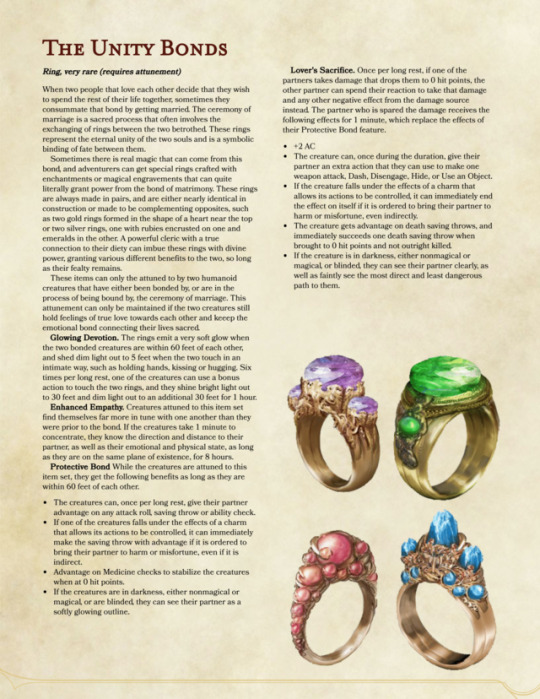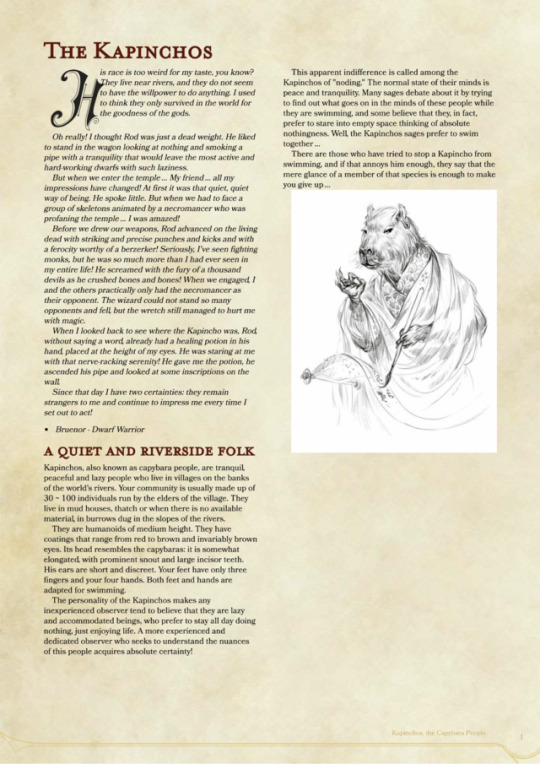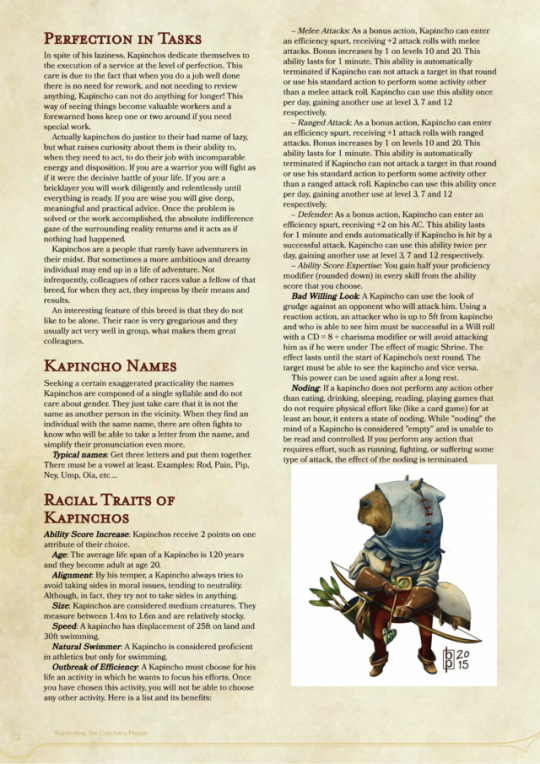Link
NPC Roleplaying Sheet (by luckpack)
“This is a non-combat character sheet meant to facilitate the process of creating and keeping track of NPCs.
I prefer giving each NPC it’s unique small sheet of paper instead of keeping them all crammed together in a notebook or something. Having a form with fillable blanks also makes it that much easier to create a large number of characters.
It’s about 10x15 cm, a quarter of the size of a regular A4 paper. Below are Google Drive download links. All PDFs have two pages; the first one is the front and the second one is the back. I used the player character sheet as reference to try to get it to be “official” looking.
[NPC Sheet]
[NPC Sheet, no lines]
[NPC Sheet, printer friendly]
[NPC Sheet, no lines & printer friendly]
Also:
All races age differently. I recommend finding or creating an “age by race” table for quick reference. I also recommend writing how mature the character is as well in case you forget how that specific race works. So for a halfling, for example, I might write “80, middle aged” instead of just the number alone.
In the “Combat Statistics” field, the idea is to write the name of a creature in the MM or other book. The NPC will utilize these stats. So for example, if I have a Captain of the Guard character and I want him to be stronger than the average Guard (p. 347 MM) I might write down “Scout, p. 349 MM.” Humanoids don’t vary that much in strength, so for the majority of NPCs you could print out a couple of obvious stats (Commoner, Guard, Acolyte, Scout, etc) and refer to them as needed. This is much more practical than printing a combat sheet for every character, considering you have no idea who players might attempt to murder.”
6K notes
·
View notes
Text
Multiclassing... With Style
Your character is close to levelling up, and you’re thinking about taking a level in another class. That’s great! However, let us not forget that this is a roleplaying game, and therefore this new character development deserves some narrative attention.
The Guild of Fifty One Hands does share secrets with anyone off the street.
The Archfey Council will not grant to power of the natural world to those it deems unworthy.
The Circle of Seven will not train an unlearned plebe to manipulate the fundamental elements of the universe.
You must first prove you are worthy of the powerful abilities associated with this new class. For each class (in the 5th edition PHB) you will find a list describing trials you may be set to prove your suitability for training.
Barbarian (1d6):
Survive a night in the gulch with only a spear
Capture a live bison (or similarly large beast) with only a rope
Cross the river at the rapids
Using only your bare hands, touch together the two ends of an iron rod
Turn the granite sculpture in front of the palace to face the opposite direction
Beat up a bear with your bare hands
Bard (1d6):
Compose a sonata in the style of a famous composer
Construct your own instrument
Perform at every inn Brognar Dovecap played at on his final tour
Recite the epic tale of Gray Wolf from memory
Sit through the entire 28 hour “Ode to Warm Milk”
Get a groupie
Cleric (1d6):
Translate a page of the Mad God’s Tome
Acquire the ingredients for incense and prepare it
Read the scripture cover to cover
Learn the fundamentals of the morningstar
Work for a time as a beadsman at the local alms-house
Finish all the paperwork in your to-do bin
Druid (1d6):
Learn the hunter’s last rites and perform them after slaying a bull elk
Allow a bird to nest in your cupped hands
Cultivate the notoriously fickle winter ivy without using magic
Earn the trust and friendship of a myconid colony
Return a defiled place to a state of natural health
Beat up a lumberjack
Fighter (1d6):
Learn the basic defense and attack forms
Win a medal in the King’s Melee
Apprentice under a blacksmith for a time
Learn the art of diplomacy
Read through Muin Wild’s ‘'The Art of Conflict”
Defeat the galloping hordes AND one hundred bad guys with swords
Monk (1d6):
Do 10,000 pushups
Learn meditation under a master
Give up your worldly possessions
Learn to perform a tea ceremony
Fast for a fortnight
Learn crouch with tigers and hide with dragons
Paladin (1d6):
Provide palliative care to the dying
Seek out a wanted criminal and convince them to amend their ways
Commit to a vow of silence, chastity, or poverty
Compose your oath and commit it to memory
Undertake a pilgrimage
Spoil a shady plan by being a huge stick-in-the-mud
Ranger (1d6):
Retrieve the herbal ingredients for an antidote before the poison overwhelms you
Capture and train a bird of prey
Climb to the peak of a mountain
Construct your own bow
Track down the cause of a blight afflicting the nearby forest
Escort some needy halflings to the nearest elf settlement
Rogue (1d6):
Steal the Red Wolf’s signet ring
Spring The Pig from the local jail
Brew a potent poison
Walk atop the city wall from one end to the other
Craft a set of skeleton keys
Go up against a Sicilian when death is on the line
Sorcerer (1d6):
Trace the history of the dragon bloodlines
Inscribe on your skin the tattoos of magic channeling
Read the Manual of the Planes
Pen a thesis on each of the four natural and seven supernatural elements
Construct a wand
Fetch water and perform other menial tasks for an Arcane Master without using magic
Warlock (1d6):
Retrieve a lost relic for your patron
Capture and tame your familiar
Perform a moonlit sacrifice for your desired patron
Craft your pact weapon
Destroy a relic belonging to a rival patron
Start a cult
Wizard (1d6):
Identify an artifact without the aid of magic
Master the process of growing crystals
Read through all seventy-seven tomes of Arcane Foundations
Learn the fundamentals of life, death, undeath, and false life
Perform the rituals required to convert a regular cauldron into a suitable potion brewing vessel
You put on your robe and wizard hat
2K notes
·
View notes
Text
Unfucking Dungeons & Dragons
The concept of some humanoid or near-humanoid species being naturally inclined to evil is a racist one, and, unfortunately, a prevalent one in Dungeons & Dragons, exacerbated by the fact that these “evil species” are frequently the “ugly” ones. Drow are a particularly glaring example - “made black because of their ‘evil’”?! Fuck you - but the duergar - “the slaves … learned only to enslave, really makes you think don’t it” - and the orcs - “they feel the CALL to evil in their Gruumshy HEARTS” - are also super not good. (There’s also a fair degree of ableism, with “insane” monsters - in such cases, I honestly think “unaligned” would be a better description for “too far gone to understand morality”. Evil implies a choice.) Honestly, I wouldn’t mind so much if these weren’t supposed to be naturally-occurring species - always evil demons or fey are fine, because they’re made of magic and stories, although care should of course be taken not to make them look like naturally-occurring species - but elves are really just fragile pointy-eared monkeys, and they have excuses. However, these evil humanoids are also genre staples and often quite aesthetically good. To that end, I offer the Unfucking D&D Guide, which provides what I think are solutions to this problem. (It should be noted that I am whiter than plain yogurt, so my ideas should be taken with a grain of salt and definitely not take precedence over the ideas of non-white folks. If I’ve said something fucked-up in this, please let me know and I’ll fix it.)
Duergar. Keep the “enslaved by illithids, made grim & psionic” bit, toss the “learnt evil from them” part. The duergar are joyless, or can appear so - you can play them either as gloomy and fatalistic or as eccentric and unreasonably concerned with “corruption” - but despite whatever mood they possess, make sure that they are thoroughly dedicated to making sure the horrors of the Underdark stay in the Underdark, and are as righteous and honorable as their hill and mountain cousins.
Derro. The derro are an “insane” species; I bring them up only because I saw them confused with duergar in one post about racism in D&D. Their lore has not been constant - the current lore is “dwarves enslaved by illithids, tortured into madness, and now they’re eeeeeeeevil”, which is ableist, not racist - but their metatextual origin is among the detrimental robots, or Deros, of pulp author Richard Sharpe Shaver’s stories (or possibly delusions). “Born from the dreams of a mad author” would actually be good lore if you can make that author a tragic sufferer of schizophrenia in a time before it was understood rather than an ~*~eViL mAdMaN~*~, but in any event, change their type to construct, fey, or fiend, and, most importantly, don’t take them seriously. The derro are pulp villains, and their evil is grandiose and nonsensical. They ought not to be seen as realistic; they ought to be seen as Snidely Whiplash, Commander Claw, or Heinz Doofenshmirtz. “Reasons” are for other genres.
Drow. Return drow to their mythical roots as trow, nocturnal hunters, tricksters, and magical artisans dwelling in the hollow hills. There’s high and wood elves; dark elves can find a niche. Lolthite culture is good villain fodder, but make sure that you can handle an “evil religion”, and make sure that all types of elves participate.
Goblinoids and trolls. Make them fey, and abandon Tolkien for Rossetti and folktale. Goblins make cruel bargains; hobgoblins attend faerie courts; bugbears hide in closets and create electricity from feed on children’s screams; trolls lurk under bridges and love riddles. As fey, they’re not evil, simply alien and lacking in empathy towards mortals.
Gnolls. If you use the Volo’s lore, change their type to fiend and be done with it. If you want to have them be natural humanoids, go read Ursula Vernon’s Digger for the best-written hyaena-furries in literature and base gnolls off that once you’re done crying.
Kobolds. Kobolds are already draconic cleaner wrasses in lore; there’s no reason that metallic dragons can’t enjoy them as well and influence some populations to good.
Illithids. The mind flayers certainly have great potential as villains. However, there is nothing about their psychology that impels them thither. Their biological requirements could easily be met by feeding on those close to death, whom I might imagine would willingly donate their brains as food or tadpole incubators in exchange for a painless death and the surety that their memories would live on in the illithid. Also, create food and water spells exist.
Ogres. Ogres are wilderness-dwellers who prefer to maintain their personal territories through fear instead of actual force of arms; the idea of the monstrous, anthropophagous ogre is a deliberate sham. They are actually capable of great heroism, even if they aren’t exactly the sharpest tools in the shed and okay to be honest I started out trying to build up to a Shrek joke but I think I’d take this over canon lore.
Orcs. Orcs are an easy fix; all you need to do is remove Gruumsh from the equation and they don’t have a bullshit “call to evil”; in Eberron, without objective gods, the people of the Shadow Marches believe that half-orcs are the proof that orcs and humans are one people, so there’s even in-game precedent for orcs as members of society.
Yuan-ti. There are two ways to do this. One is to dump all the lore and just have sexy snake cults, although don’t dress them like Asian or Aztec stereotypes like a lot of the art does. (The 3.5 Monster Manual yuan-ti pureblood looks like she’s constantly accompanied by an inappropriate bamboo flute riff, I swear to Istus.) A sexy snake cult (and I am including malisons, abominations, and anathemas in the term “sexy”, not just purebloods) should be fun for everyone.
The other way is to keep their personalities and dump everything else, because if you keep that, you get truly excellent villains. I mean, these fuckers. How dare they drag something as pure as snakes into their Ayn Rand bullshit. Villain yuan-ti should be something transformed from willing or deluded humanoids (histachii raise the sacred snakes and the children of the yuan-ti, who possess their parents’ original race at birth). Couple that with the fact that since snakes very definitely have emotions, yuan-ti logically should as well, which means that they only think they’re above emotions. Now you have Objectivists roped into a magical pyramid scheme, which should offend no-one who doesn’t deserve it. You can mourn for the beings they once were, or just laugh in their dumb faces. Also, the sexy ones all look like Ayn Rand.
22K notes
·
View notes
Photo

Ever wanted to get into Dungeons and Dragons but didn’t know how or felt intimidated by game shops? Joined a group only to be made to feel bad for being a newbie or were made uncomfortable by rude men at the table? Just wanna chill and talk D&D with a group of super rad women and NB folks? There’s a discord channel for that! We’re only a week old but we’ve already surpassed 100 members and they’re all lovely, inclusive as heck and welcoming. We do weekly events (like movie screenings!) and have already gotten 3 games started via our “looking for a group” sub channel. We also boast a really robust resources sub channel that acts as a comprehensive tabletop RPG library. If you’d like an invite shoot me a message and I’ll hook ya up! If it’s not for you but you’re still hype about it, reblog so lots of folks can see this rad community! Thanks!! 💖💕
4K notes
·
View notes
Photo
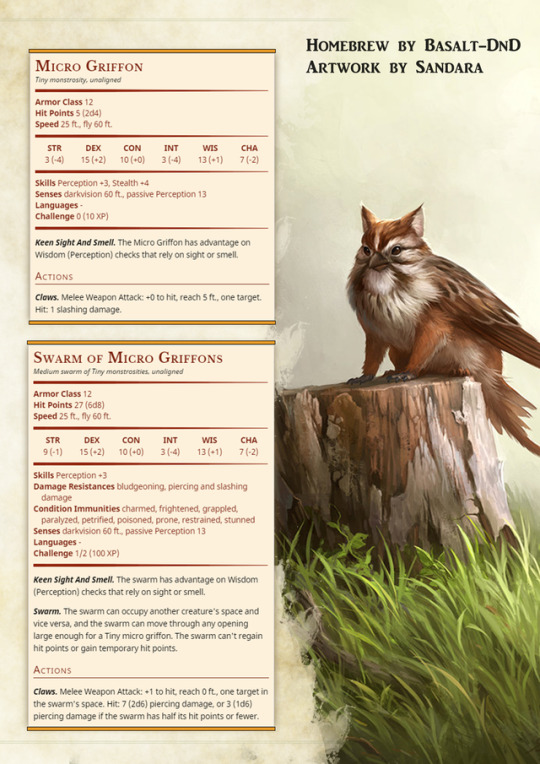

Tiny griffons for all of your animal companion or obscure-mob-attacking-the-party-in-the-forest needs.
Artwork by Sandara, the first piece is here and the second is here. The swarm was inspired by another piece of hers.
5K notes
·
View notes
Photo
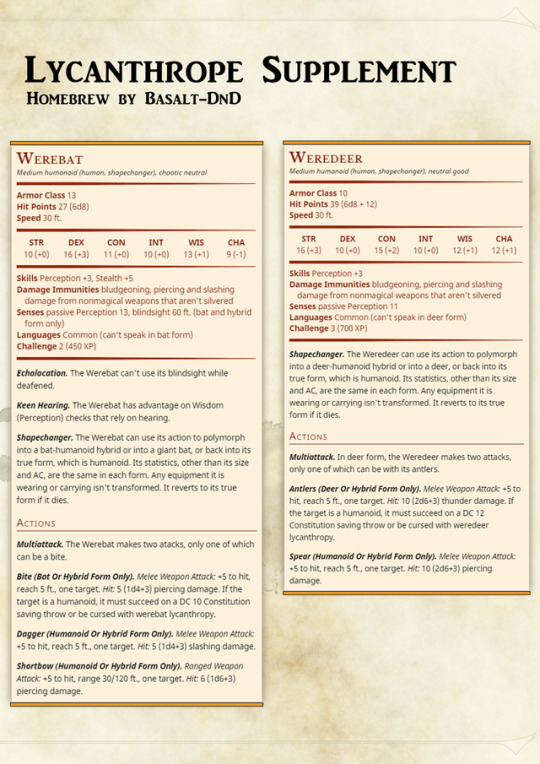

A few homebrew lycanthropes. I may see if I can make a homebrew rule-set for player characters as lycanthropes, because the current rules for it in 5e… well… They can be a bit too powerful.
924 notes
·
View notes
Photo

http://geekandsundry.com/the-5-fears-of-first-time-dms-and-how-to-vanquish-them/
It’s a beautiful moment in every aspiring DM’s gaming career: the first time you run your own game. But no matter how long you’ve been playing, that first session on the other side of the DM screen can be pretty scary. Let’s lift the proverbial construction paper on this dungeon and take a…
346 notes
·
View notes
Text
Managing Horror Adventures

Running an adventure with a gothic or lovecraftian core has crossed the mind of most DMs, but effectively incorporating this type of narrative to D&D games has it’s own challenges. Humor and the parodying fantasy tropes are a fundamental part of most fantasy RPG tables, and this clashes with the intended tone of such campaigns. Asking for the player’s cooperation in carrying the mood before starting is important, but the heavy lifting will have to be done by the DM. Kobold Press posted a series of articles with suggestions on how to manage the mood at a table, Don’t Look Now: Handling Fear and Suspense in Fifth Edition:
Part 1 - The Birth of Something Creepy
Part 2 - Appealing to the Senses
Part 3 - The Monster After You
Part 4 - Deep Dark Places
You can also check the following resources:
RPG author Ash Law’s The Trajectory of Fear – or How to Use Horror Tropes Effectively in your Game, digests the narrative structure of a good horror game-story
Good discussion among forumers in the Minmaxboards, touching on topics like the problem with powerful characters where helplessness is desired, the need for players cooperation towards the mood, and the possibility of the DM rolling Stealth rolls to promote uncertainty.
And of course, a good soundtrack can make the difference, so check out my Sounds and Music post with tips for that.
240 notes
·
View notes
Text
So I was thinking of just something dumb to make a character around
And I know it’s probably been done a thousand times, but I think it would be fun to play as an awoken dog. Do whatever to determine stats, but I think it would be fun to play like a Fighter or, DM permitting which at this point I’m probably stretching it, a Paladin. The idea of my character either holding a blade in their mouth or just straight up biting someone and dealing smite damage.
176 notes
·
View notes
Photo



My girlfriend made these amazing hand-drawn class-specific character sheets that can be used to play 5th Edition. All 12 base classes are represented and they’re all customized to have everything you need to play that’s not found on the basic character sheets. Printable & PDF form fillable! A great pickup, check ‘em out: > More pictures. > Shop & Specific sheet details.
27K notes
·
View notes
Text
D&D: Teamup Attacks

A neat way to encourage teamwork and partnership midcombat: get a bonus when you combine your action with another character! You’ve probably seen things like it before in comics and action movies. The “fastball special” when Colossus throws Wolverine at an enemy. Hawkeye firing an arrow with Ant-Man hiding microscopically on the arrowhead. The ol’ one-two.
The mechanic I’m using for this is to let players use a teamup attack whenever two players roll the same intiative result, but you could feasibly let them do it if they ready their actions appropriately and make proper rolls for whatever they are trying to do. But otherwise, you just add some sort of condition or bonus damage to the attack, along with the regular damage from both players’ attacks. It’s that easy! After the first teamup attack, the players resolve initiative normally by figuring out which player has the higher modifier or rerolling.
The fun part of this mechanic is you or your players coming up with a special attack! Check out some examples I came up with below.
Fastball Special
Half-Orc Barbarian + Halfling Rogue: The Barbarian uses their strength to throw the rogue at an unwary enemy! The attack deals the regular sneak attack damage plus the barbarian’s regular attack damage, and then knocks the target prone.
Timber!
Fighter + Druid: The Druid casts Entangle or Thorn Whip or some such spell to wrap up the target’s feet, setting up the Fighter (or any martial class, really) to knock them down with a heavy blow to the torso or head. This deals the Druid’s normal damage from the spell (if applicable) and then the Fighter’s damage, plus knocks the target prone.
Shadow Boxing
Way of Shadow Monk + Assassin Rogue: Alternating attacks from each player jumping out of hiding and back into the shadows between each strike confuses the enemy. The target has disadvantage on all attacks during its next turn and cannot move more than 5 feet. It also takes the Monk’s and Rogue’s regular attack damage.
Nail on the Head
Great Weapon Paladin + Archery Ranger: The Ranger hits the creature with an arrow, and then the Paladin follows through with their two-handed maul, hammering the arrow deeper into the creature’s wound. This deals regular damage from the Paladin and Ranger plus causes the creature to bleed for 1d4 damage each round for three rounds.
Come to Deity
Paladin + Cleric: One of the players sweeps the target’s feet and the other whacks the back of their head, causing the target to fall into a kneeling position before the two holy heroes. The damage from both players coupled with their righteous auras causes the creature to become Frightened for one round.
Who Turned Out the Lights?
Fighter + Rogue: The Rogue pulls some of the target’s clothing or a bag over the target’s head, blinding them for 1 round if they are subject to such a condition. The Fighter and Rogue then wail on the creature with their attacks, each of which is made at advantage.
Soul Shred
Good Cleric + Fiend Warlock: The two players blast the target with spells of both fiendish and celestial energy, like an Eldritch Blast and Sacred Flame. The diametric energies surge through the target and vibrate enough to damage their very soul. The creature gains 1d3 levels of Exhaustion in addition to regular damage.
Elemental Convergence
Sorcerer + Wizard: The two spellcasters cast spells with different energy types simultaneously. The target(s) are Stunned for one round from their bodies trying to recover from the shock to their system. The creature or creatures take regular damage from the spells.
Harmonic Spell
Bard + Sorcerer: The Bard guides the energy of the Sorcerer’s spell with their musical magic, fascinating everyone who can see the spell (but not the initial targets of the spell). These creatures gain disadvantage on Perception checks and have their attention drawn to the spell’s effect, even if they were in the middle of combat, giving their enemies a chance to make Stealth checks. The Bard adds a die equal to their Bardic Inspiration die to the Sorcerer’s spell damage, without expending a use of Bardic Inspiration.
Arcane Epiphany
Wizard + Wizard of different school: The two Wizards combine the culmination of their studies to reach a magical revelation of sorts. They can each combine a spell from their chosen schools of magic to create a new spell, limited only by the imagination of the two players. For example, a Shocking Grasp and Phantom Steed launches an electrified steed at the target, becoming a regular Phantom Steed after the damage is dealt. The spell combines the damage of both base spells plus 2d6 damage, if either of the spells deal damage.
Rain of Arrows/Torrent of Blows
Ranger + Ranger: The two Rangers barrage the target with either their dual weapons or multiple arrows. The creature hesitates offering each ranger time for an additional attack in addition to their regular attacks, each at -1.
Look Behind You
Archery Ranger + Rogue: The Ranger and Rogue attack from hiding and use each other’s attacks to distract the creature from one another. The attacks deal a bonus 1d4 damage and do not reveal either player’s hiding place.
Beastcall
Bard + Druid: The Bard’s music combines with the Druid’s natural affinity to call a woodland creature to aid in the battle. This round, the Bard and Druid both deal damage from their respective spells or attacks. Next round, between the Druid and Bard’s initiative, a beast of CR 2 or less arrives to make an attack against a target the Bard and Druid agree upon, using the higher of the two characters’ proficiency modifiers to the attack and damage rolls. The beast then retreats back into the wilderness.
Eldritch Infusion
Warlock + Barbarian: The Warlock infuses the Barbarian’s open mind with the force of their patron to fuel their rage. The Warlock can use its action each round to maintain this bond. While infused, the Barbarian’s last attack each round deals damage equal to the Warlock’s Eldritch Blast damage plus 1d10 additional damage.
Dragoncall
Cleric + Draconic Bloodline Sorcerer: Through the Cleric’s exaltation to the draconic deities and the Sorcerer’s draconic origin, the two of you call a dragon to your aid. The Cleric and Sorcerer deal no damage this round. Next round, however, a Young dragon of the Cleric’s or Sorcerer’s choice arrives to use its breath weapon on a 15′ radius area they agree upon, using the dragon’s regular damage and saving throw. The dragon then leaves once its air raid is complete. (this one is a bit of a stretch, but I think that it’s fair if they forego their damage for a round to gain about 16d6 (possibly halved) damage on a small area.)
7K notes
·
View notes
Photo






I’m really excited to share this find!
I found these treasures on Amazon, in a pack of 36. They’re small plastic knight figurines, with bases just small enough to fit in 1’ tiles. Perfect for D&D games!
They come in 6 different figures, with spears, swords, halberds, maces, and bows. Both grey and black in the pack.
They are a bit larger than the standard mini, but they make it easy to show larger hordes of enemies on the map.
They’re selling at $8.09 right now and you can order your own pack of 36 here: https://www.amazon.com/gp/aw/d/B000YA7FS6/ref=mp_s_a_1_fkmr0_1?ie=UTF8&qid=1474044146&sr=8-1-fkmr0&pi=AC_SX236_SY340_QL65&keywords=Toysmith+36-Piece+Guardian+Knights+Action+Figure+Set+https%3A%2F%2Fwww.amazon.com%2Fdp%2FB000YA7FS6%2Fref%3Dcm_sw_r_cp_api_Pcc3xb00S047G
106 notes
·
View notes
Video
youtube
(via https://www.youtube.com/watch?v=0K9mKpAMREU)
0 notes
Text
Things this DM prefers to skip/ignore
Time is valuable, and I prefer to use my game time focusing on things that are more interesting to the players as well as myself. Especially relevant since I get less than 2 hours a week with one of my groups.
Experience points. You level up when I think it’s appropriate.
Calculating/dealing with how much money weighs. As far as I’m concerned all money exists in a convenient pocket dimension until you need it.
Inventory management for food/water. I assume that you eat and drink when necessary, and stock up on rations when you’re able. This only becomes relevant in extreme survival situations.
Going to the bathroom. I personally don’t want to hear about it.
Inventory management for familiars. I assume you’re feeding the damn things and taking care of them in general. I’m okay with players who roleplay their familiars constantly, but I also have nothing against familiars who only exist when they are needed pretty much.
Keeping track of ammunition. Infinite arrows/bolts/bullets for all I care. Unless they’re enchanted or otherwise special.
Ride checks for basic getting from Point A to Point B. Unless you’re trying to go really fast or do something fancy, I assume you somehow work it out. Or unless you’re trying to ride something exotic I guess.
Going through the whole Night Watch thing every night. Early on I have players establish and normal night watch shift pattern, and I assume that is what they do unless they tell me otherwise. So when we want to get back to the story quickly, I can just tell the players that they used their regular night watch and nothing of interest occurred. No bother having players describe setting up camp and everything.
Identifying common/basic magical gear. You don’t have to roll spellcraft, appraise or use the Identify spell if it’s an item you’ve seen before. I don’t want players to waste too much time figuring out what their loot is unless it’s specifically a mystery or something really high level and cool.
Confirming Criticals. This goes for both crit hits and crit misses. This one is more of a personal preference, and I let the group vote on whether they want it or not. One of my groups skips the step of confirming crits and I like it. The exception is if you have a wide crit range and roll below a 20. But on a 20 or a 1, something interesting always happens.
Anything you prefer to skip/gloss over? Disagree with any of my choices?
262 notes
·
View notes
Photo

Matt Mercer is the master of cool who makes the rules.
Watch him here: http://bit.ly/1VcaxDp
408 notes
·
View notes
